This Guide will teach you everything you need to know about Drip Irrigation.
Components Of Drip irrigation system
Cost of installation
Government subsidy
And Guidelines For Maintenance and much other valuable information that I’ve never shared anywhere else before.
Let’s get started…
The available water for agriculture decreases day by day due to the increase in population, industrialization, and short rainfall. It has become essential to use modern irrigation technologies like Drip irrigation, sprinkler irrigation in agriculture.
Drip irrigation means providing the required quantity of water directly to Crop plants’ root zone through a network of small pipes; this is also called micro-irrigation or trickle irrigation.
This is the most efficient irrigation technique.
In the Drip irrigation system, water supplies to plant roots through a collection of plastic pipes, lateral tubes, and valves. These components, controlled with the help of a dripper and water pump. With the help drip irrigation system, it is easy to provide liquid fertilizer to the plant root system.
Drip Irrigation Advantages
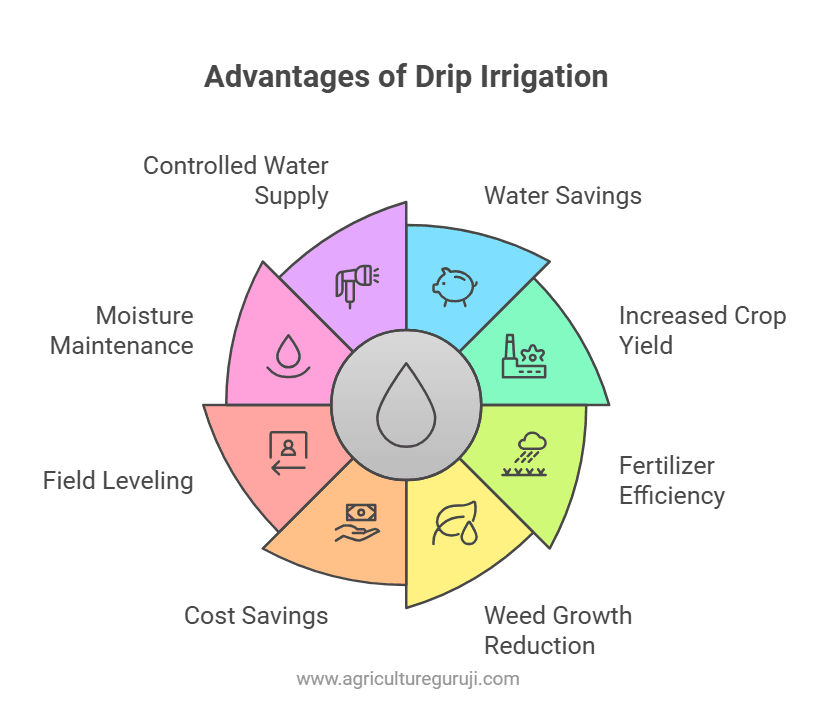
- Drip irrigation Saves water around 30% – 60% as compared to flood irrigation.
- It is observed that crop yield increase up to 230%.
- Fertilizer use efficiency increase by 30 percent
- Reduce Weed growth
- Save Labour and electricity cost is much significantly less than other irrigation methods.
- For drip irrigation, Field leveling isn’t vital.
- Easy to maintain Moisture near the root zone
- Water supply is extremely optional, controlled by way of each nozzle.
- Help to reduce Soil erosion.
- Enable the use of saline water for irrigation
Components Of Drip irrigation system

The drip irrigation system comprises the water pump, filter unit, mainline, sub-mainline, lateral pipes, dripper, and other accessories such as control valves, pressure gauge, Fertilizer tank/venturi, end cap, etc.
1) Water Pump
A pump of a suitable capacity Water pump is used to supply water through the drip irrigation system components at a specific level of pressure.
If the source of a water supply is a bore well, open well, or a Canal, there is the possibility of organic and inorganic foreign bodies in the water. In this case, use the suction filter to get relatively clean water.
The electric motors or diesel engines are the common prime mover of the pump. Recently the solar pump is being used to popularize it for drip irrigation purposes.
2) Filter unit
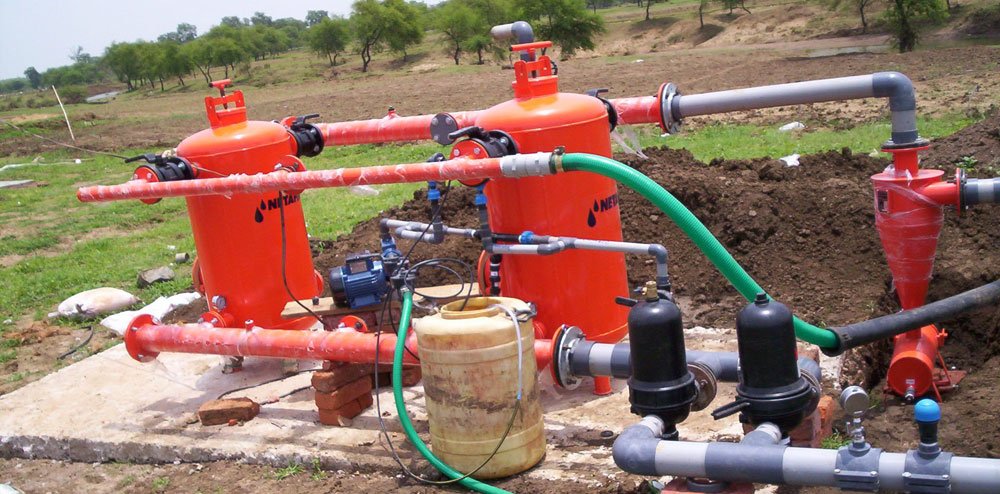
There should be a good quality filter in the control head installation of a drip system. The filter uses to clean the suspended impurities of water supplied by the pump before it reaches to drippers. Impurities in irrigation water may cause blockage of the holes and passage of drippers.
The success of drippers greatly depends on the performance of the filter.
A filter unit cleans irrigation water impurities that are suspended and prevent blockage of holes. There is various type of filter available in the market.
There are Three Types of filters: Hydrocyclone Filter, Media filter, and Screen or Disk filter.
Suitable filters are installed according to the impurities found in the source of water.
If the water source is a bore well with less physical impurities, you can install only a screen filter.
If the water source is an open well or a Canal install screen or disc filter along with sand filter and Hydrocyclone Filter.
To work the drip irrigation system properly two-stage filter unit is used.

a) Media (Sand/ Garval) Filters

These filters come as the primary filter unit, and this is powerful against inorganic suspended solids, biological materials, and other organic substances.
Media Filter consists of fine gravel and sand of selected sizes placed in a pressurized tank. It helps to remove organic substances such as algae and other vegetative substances present in the water.
The filters are made up of a circular tank filled with layers of coarse sand and different gravel sizes with a provision of valves or flushing the filter assembly in case of clogging.
The media filters are available in different sizes ranging from 500 to 900 mm diameter with an output of 15 to 50 Cu.M., respectively.
A gravel filter or sand filter is vital for the open reservoir, even where algae growth occurs in the water source.
b) Hydrocyclone Filter

If the irrigation water contains more sand particles, hydro-cyclone type filters are removed this sand particle by creating centrifugal force and spins out sand from water.
The Hydro-cyclones Filter generates a spinning activity causing the sand particles to separate the water and be trapped in a storage tank at the bottom of this device.
Hydro-cyclone type filters are produced in various sizes for different discharge capacities.
c) Screen Filter:
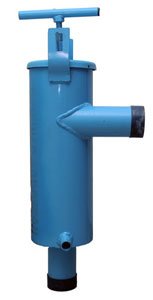
In general, the screen filter consists of a single or double perforated cylinder placed in a plastic or metallic container
for removing the impurities.
Generally, 100 to 200 mesh screens are used in this type of filter. It must be cleaned and inspected periodically for satisfactory operation of any drip system.
Screen filer is installed with or without a gravel filter, depend upon the quality of irrigation water. The screen filter is made up of non-corrosive plastic or metal substance.
c) Disc Filter:

Disc filter comes as part of the secondary filter unit. Multiple circular discs filter water. it is made up of high-quality plastic material
3) MainLine:
The mainline transfers the total amount of water for the irrigation system. It connects the different sub-mains to a water source. The main pipes are commonly made of flexible materials such as PVC (polyvinyl chloride) or plastics.
The mainline pipe passes water from the filtration unit to the sub-main pipe. This pipe’s diameter depends upon drips irrigation system flow capacity, normally 2.5 – 4 Inch diameter PVC pipe used as main-line.
Mainline & sub-main should be installed in a Telescopic manner; that is, the pipe with a larger diameter should be connected first, followed by pipes with a smaller diameter. This arrangement helps to maintain uniform pressure in the system.
The Mainline should be buried at least 45 centimeters to prevent them from getting damaged during cultural operation.
4) Submain:
The sub-main feed to the laterals on one or both sides. It is made of either medium-density polyethylene (PE) or PVC. There should be a balance between the diameter of the main and sub-mains.
These are determined in consideration of the rate of discharge, number of sub-mains, and friction losses in pipes
5) Laterals:
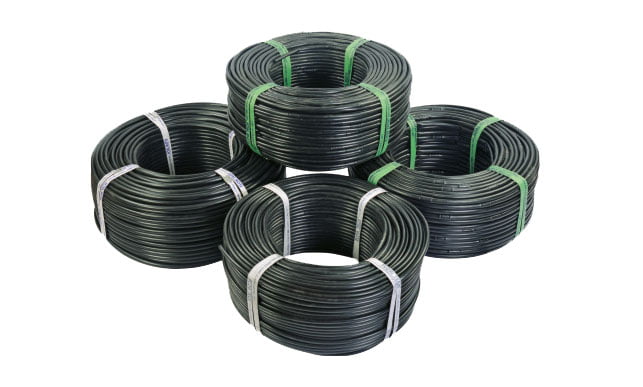
Laterals are made up of low-density polyethylene (LDP) or linear low-density polyethylene (LLDPE) material and are available in different sizes, 12 mm, 16mm, and 20 mm.
Based on the availability of water, crop, and spacing, 12 millimeter 16-millimeter laterals install.
6) Drippers:
Drippers are also called emitters. The dripper is discharging water from the lateral pipe to the soil.
Drippers are generally manufactured from polypropylene materials.
Mainly, two types of drippers are available in the market. Online Dripper and Inline Dripper
a) Online Dripper:
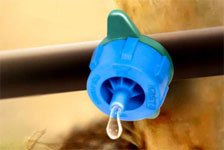
In this type of dripper, they are placed on the lateral, called an online dripper. these drippers are fixed on the lateral by punching suitable size holes in the pipe
This type of dripper uses mostly for Orchard Crops like coconut, pomegranate, guava, etc., the capacity to discharge water available is 2L/hour, 4L/hour, and 8L /hour.
b) Inline Dripper:
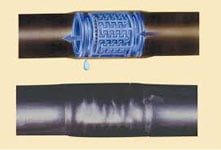
In this type, the dripper is placed inside the lateral pipe. The distance between the two drippers is the same. There are three types of available inline drippers.
Non-Pressure Compensating Drippers (NPC): This is a very simple dripper, which does not maintain uniform pressure
Pressure Compensating Drippers (PC): This dripper is more advanced; it maintains uniform pressure in all drippers. It mostly uses for the greenhouse crop, the price of this dripper is slightly high.
Non-Draining Drippers: This dripper is mainly used in a soilless-like mediums like cocopits, Perlite, and Vermiculite.
7) Fertilizing Unit
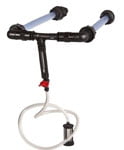
The direct application of fertilizer through drip irrigation has increased the efficient use of fertilizer and saving in labour and money.
With this fertilizing unit’s help, liquid fertilizer is provided to the plant through a drip irrigation system.
Application of fertilizer into irrigation system is made by either a by-pass pressure tank or by venture pump or direct
injection system.
8)Pressure Gauge:
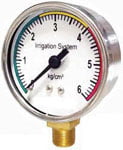
It is used to determine water pressure in the drip irrigation system.
8) Controls Valves
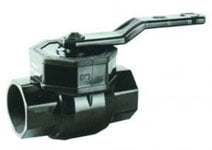
This value is used to control water flow. They made up of plastic and iron material
9) Flush Valve:
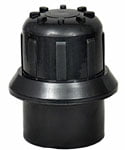
The flush valve is placed at the end of the sub-Maine pipe it uses to flush out dirt.
10) Non-Return Valve
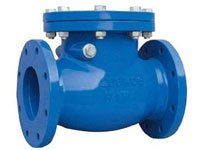
Non -return valve is useful to stop return water toward the water pump.
11) Air valve

It helps prevent the sucking of mud by the drippers and release air into the drip irrigation system.
12) Endcap
The end cap is used to close one end of the lateral pipe; they remove it at the cleaning time.
Types of Drip Irrigation System
Their many types are available in drip irrigation here. Only two popular types are explained.
1) Surface drip system
In the surface drip system, the emitter and lateral pipe are placed on the soil surface. This is the most common and popular type of drip system.
It is suitable for wide-spaced plants as well as for row crops. It is easy to use a surface drip to observe and inspect, change, clean the emitters, observe surface moisture patterns, and measure individual emitter discharge rates.
2) Sub-surface drip system
in a subsurface drip irrigation system, the lateral is placed below the ground and near the plant root zone area. In this system, water is slowly applied below the surface through the emitters.
Sub-surface drip systems have gained wider acceptance due to removing earlier problems of clogging to a large extent.
Due to the sub-surface drip method, there is less intervention in agriculture or any cultural practices and possibly more operational life.
Sub-surface drip system provides little interference with cultivation or any cultural practices and possibly longer operational life.
Drip Irrigation System suitable for this crop
| Crop Type | Crop |
|---|---|
| Vegetables | Tomato, Capsicum, Cabbage, Chilly, Cauliflower, Onion, Brinjal, Bitter Gourd, Ridge Gourd, Peas, Cucumber, Pumpkin, Spinach etc |
| Cash Crops | Sugarcane, Tobacco, Cotton |
| Poyhouse crop | Gerbera, Dutch rose, Carnation, Anthurium, Lily, Orchids, Strawberry, etc |
| Plantation Crop | Coffee, Coconut, Tea, Rubber, etc |
| Orchard Crops | Banana, Grapes, Citrus, Orange, Pomegranate, Mango, Guava, Pineapple, Cashewnut, Coconut, Papaya, Watermelon, Muskmelon, Litchi, Lemon, etc |
Drip Irrigation System Cost
The Cost of drip irrigation system installation depends upon various factors, like what kind of crop you are sowing, type of terrain, quality of soil, sowing pattern, water quality, quality of drip material, manufacture company of drip irrigation system, and design of the drip irrigation system.
Drip irrigation system cost per acre For vegetable crop will come around Rs. 50,000–65,000 per acre approximately and For fruits crop, if planted in the 3X3 pattern cost per acre for drip irrigation system come around 35,000- 40,000 approximately.
Government Suggestive cost of drip irrigation system:

Ref: Pradhan Mantri Krishi Sinchayee Yojana (PMKSY)
Suppose you are using non-ISI material; your initial cost for one acre comes around 20,000-25,000 rupee for the vegetable crop, but the life of non-ISI material for 2-3 years with high maintenance cost. At the same time, the life of ISI material is 7-10 years with low maintenance.
Government subsidy for drip irrigation
The subsidy is available for Drip irrigation in India under Pradhan Mantri Krishi Sinchayee Yojana (PMKSY). The government of India gives subsidies per beneficiary up to 5 hectares. There has been financial assistance under different categories and depending upon States’ categories for dessert, drought, hilly, and other regions of the country. For more detail, check the PMKSY website or contact the nearest agriculture office.
List of Top Drip irrigation companies
These are the Top Drip irrigation manufacturer company in India.
Guidelines For Maintenance Of Drip irrigation system
Drip irrigation is a mechanical system, which performs at a specific pressure of water; if the system has to perform well for a long time, the pressure should be properly maintained.
Even if good quality materials are used and installed scientifically, there is a possibility of failure. If the field maintenance is not proper and regular, therefore, the drip irrigation system’s management is very important.
Follow these guidelines to maintain drip irrigation system –

A. General care
- Check all Working emitters or Dripper, Inspect the water leakage, and make sure that water is uniformly distributing all of the corners of this plot/field.
- Check the water dispensation area. If their dry patches are found, increase drip irrigation operation time.
- If a twist, fold, cut, puncher is observed on the lateral, sub-main, valve correct it immediately.
B. Clean the filters.
The filter is the main part of the drip irrigation set. If the filter is not working properly, there is a major chance of complete drip irrigation system Failure.
1. Sand filter:
Clean sand filter after every week. The backwashing facility available in the sand filter uses this by allowing water to flow through the lid instead of the water valve and stir the sand in the filter. So, the waste which is sitting at the bottom will come and go out of the water
2. Screen Filters/ dice filter:
Open the lid and remove the mud and garbage trapped. Open the filter and remove the filings and rubber seals and clean it on both sides.
3. Submain pipe and Laterals tubes:
Sometimes a fine particle, dirt passes through the filter and store in the main and sub-main tubs, Laterals; therefore, to clear these tubes, remove the end cap, Flush Valve and let the water flow. Do this until the clean water come.
C. Chemical Treatment:
The drippers are stopping working due to various alkali
If the amount of carbonate, bicarbonate, chlorides, sulfur, manganese, and calcium, sulfur sulfate is higher in water, yellowish dots appear, and the reddish dots appear dripper, and if the amount of iron is high red spot appear on the dripper following treatment carried out.
1. Acid Treatment:
Acid treatment is useful for though dripper and laterals blocked by various chemical impurities, including fertilizer residue. This impurity can be removed by treating the system either with hydrochloric acid or sulphuric acid or nitric acid. This hydrochloric acid at 25% is best for acid treatment.
Method:
Take the required amount of hydrochloric acid in water. Inject it into the system through the Venturi or fertigation tank. The system is filled with water allows acid solution into the system until the pH of 4. A check pH with litmus paper for both at the starting and the last dripper. Close the system for 24 hours.
The acidified water in the system reacts with the salts deposited in the system and dissolves it. After 24 hours, they acidify water along with the dissolved solids coming out of the system by flashing.
2. Chlorine treatment:
Chlorination is useful to remove the biological impurities collected in the drip irrigation system. Chlorination can be done either using calcium hypochlorite, sodium hypochlorite, chlorine or calcium hydrochloride, or bleaching powder.
Method
Dissolve the required quantity of bleaching powder in water one day before treatment. This solution is let into the system through Venturi or fertigation tank and allows it to stay in the system for 24 hours. after that, open the end caps of the lateral and run the system for about an hour so that the impurities are thrown out of the system
Drip Irrigation Disadvantages/ Limitation
Despite observed successes, some problems have been encountered in applying water with drip equipment for some soils, water qualities, and environmental conditions. Some important limitations are described below:
1) Persistent Maintenance Requirements
Dripper clogging is considered the most serious problem in Drip irrigation unless preventive measures are taken. It is, therefore, necessary that water should be filtered properly.
Besides this, salts and chemical deposits can be deposited in an emitter or lateral pipe. This leads to Clogging. It will adversely affect the rate and uniformity of water application, increase maintenance costs, and result in crop damage and decreased yield if not detected early and corrected timely.
Other maintenance problems include pipeline leaks and cracking of the tubes. Rodents, coyotes, rabbits, and dogs can chew and damage dripline, and ants and other insects occasionally have enlarged openings in drip tubings.
2) Economical – Initial cost
As the equipment requirements are numerous with drip irrigation, initial investment and annual costs may be high compared to surface or portable sprinkler irrigation systems.
The actual prices of drip irrigation system equipment will vary greatly depending on the types of crops, grades of pipelines, filtration equipment, and fertilization equipment, etc.,
3) Salinity Hazards
If the drip system is used under saline conditions, it should be taken extra care to manage drip irrigation work properly.
4) Technical knowledge
High skill is required for drip irrigation system design, installation, and subsequent operation.
Technical improvements in the designs of emitters, fittings, filters, etc., have been necessary;
The development procedures for preventing or correcting emitter clogging and equipment failure have been difficult, and the development of the proper methods for injection of fertilizers and other chemicals has sometimes been a
Problem.
A higher level of design management and maintenance is required with drip than other irrigation methods.
Image source :




Very important and help full information ….
I drpbnair want to start drip irrigation for 3 acre to plant banana plants. Pls connect with supplies. Mobile number 9447304753
Hello Dr.p.bhuvanendran nair,
Please contact us at [email protected] or call us at 8788462787
I am impressed after reading your article, it is so detailed that one can easily understand. Please give your mail id and mob no.
Abhijit
Thanks, Abhijit
you can contact me – [email protected]
It is a great information, do we can download the study materials.
Hello Dipankar,
Thank, you can use this information for education purpose.
Very useful information . Please provide mail ID and ph.no . Thank you.
Hello sir,
Thank for the comment, you can email us on [email protected], and you can call/WhatsApp on 8788462787.
Hello Mr. Amar
I really appreciate you for providing all these valuable information. At the same time, I am very thankful to you for all this. I have read nearly all your articles related to crop and vegetable farming. These are very content full and essay to understand. Here my point is there is still some topic which should be addressed. No doubt there are so many topics but what I suggest and request is the topic like, Drip irrigation fertilization guide, guide to choose hybrid seeds, Sources to buy reliable hybrid seeds. In my opinion, Information on these areas will complete your other articles. And help the formats in there core problematic areas. I am not a farmer but I want to be my hobby. I hope you got my words.
Thank you.
Thank you so much, sir we already coved about drip irrigation in The Ultimate Guide for Drip Irrigation (2019)
Useful information for farmers
Thanks
Hi, I like what you’re doing
Thank you, Jaafar
Many thanks for sharing the detailed information. Really appreciate your efforts.
Thank You, Venu
Hello sir
I want to know details that how much it cost to do for 5 acre in Gujarat with all subsidy that provide by government.
Thank you
Sumit Hisoriya
Hello, sumit,
Please contact us on 8788462787, so we can provide proper guidance.
Article is explained in simple & very good manner. This information easily gives better idea of drip irrigation system.
Thank you, Atul
Very useful information to every beginner.Thanq very much for your valuable information.
Thank you
It’s really good information for every agriculturist.thanks for right information…
Thank you Ganesh
Very good information 👌👌🙏
Very nice information . Thank you
Thank you sir
Help full Information
Thank you Gireesh
Thanks for giving detailed information about drip
I am from Maharashtra
I think you also from Maharashtra
Is drip irrigation beneficial for sugarcane in half Acre
Definitely beneficial for sugarcane
I wish to speak to you for consultation.
please contact us at 8788462787
Mr Amar, Very insightful article. Looking forward to read new updates on the same in coming days.
Sunny John
sure, Thank you
Excellent information Amar Sawant ji. . .
Thank you
Very informative and understandable for a nontechnical person I can understand that you’re very passionate about your work Keep up the good work and my wishes to you to grow and help many more
Thank You
Thanks
Very important information given
Thank you, Govind.
खूप छान माहिती सांगितली सर एकदम सहज समजण्यासारखी….
Thank you sir
Thanks sir for providing such a good information.
Thank you Sambasiva
Informative content,
Thank you
It’s a very useful information
Thank you, Dr.Mohammed
Very nice and useful article,thanks a lot for good information 👍
Informative, thanks.
This article is an invaluable resource for anyone interested in drip irrigation. It offers comprehensive guidance, simplifying the complex world of efficient watering systems. With its clear explanations and practical tips, it empowers readers to make informed choices and reap the benefits of water-saving, precision agriculture. A must-read for growers and gardeners!
Hi,
Its very informative and easy to understand, Further I would like to know how we use latest technology such as IOT to automate, monitor the drip-irrigation system. What are the components we can automate and monitor so that we can save more water , increase the life of system and improve the crop yield.
Thanks
Ravindra Bankar
Sure , we will update soon.